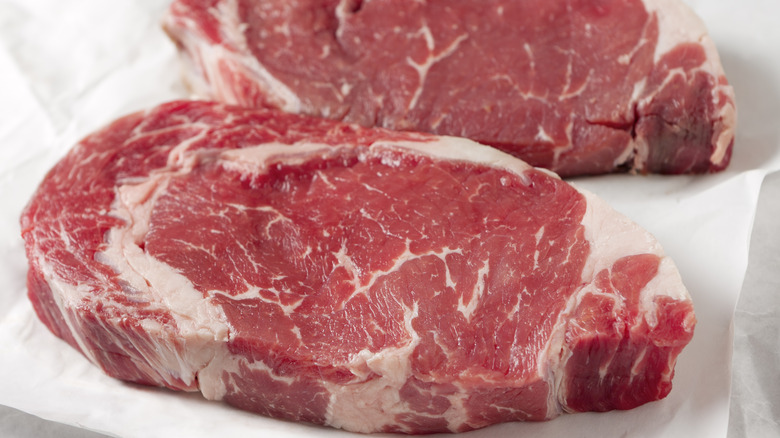The Cuts Of Steak That Were Anthony Bourdain's Favorites May Be Unexpected
Anthony Bourdain has long been a cherished figure in the culinary world, beloved for his honesty and genuine love for good food, regardless of how fancy or simple (except desserts, of which he was not a fan). That love may have begun with an oyster, but seafood wasn't all the globe-trotting chef loved. A good steak was right up there, too.
As an experienced professional, Bourdain didn't reach for whatever was available at the supermarket. He sought steaks cut from the rib primal, one of eight primary cuts of beef from which all other cuts originate. He selected these because, as he told Tech Insider, they contain a "perfect mix of fat and lean," meaning they're packed with flavor but still wonderfully tender. In fact, he preferred them to filet mignon, which he described as a "joke" looked down on by chefs who "never order it."
Of the rib cuts, Bourdain preferred entrecote, cote de boeuf, and rib steak. These cuts do have technical differences such as whether the bone is included or not. However, unless you're running a French restaurant, you can just think of them as names for slightly different ribeyes.
How to select your own rib cut steak
While you could always ask your local butcher to help you out, it doesn't hurt to know how to select a good steak on your own. Start by picking a specific rib cut. This boils down to boneless or bone-in ribeyes. Bone-in options have the potential to be juicier, more flavorful, and look amazing on a plate, but in essence there's no real difference between the two, so follow your heart.
Next, you need to understand the USDA's three-level grading system. Steaks labeled "select" have little marbling (streaks of flavorful fat in the meat). This is the kind of cut you use when steak is an ingredient, not the main attraction. At minimum, you should use choice. Choice cuts are characterized by excellent marbling and tenderness. However, if the occasion is special, you can upgrade to prime. These have the very best marbling and are the most tender, making them the best steak to throw on the grill.
Finally, some other tips to keep in mind: Look for thin streaks of marbling throughout the beef to ensure the fat melts evenly into the meat. Also, avoid fat that isn't bright white and meat that isn't nice and pink, and skip steaks with excessive liquid inside the package, as they may have been frozen and thawed.

